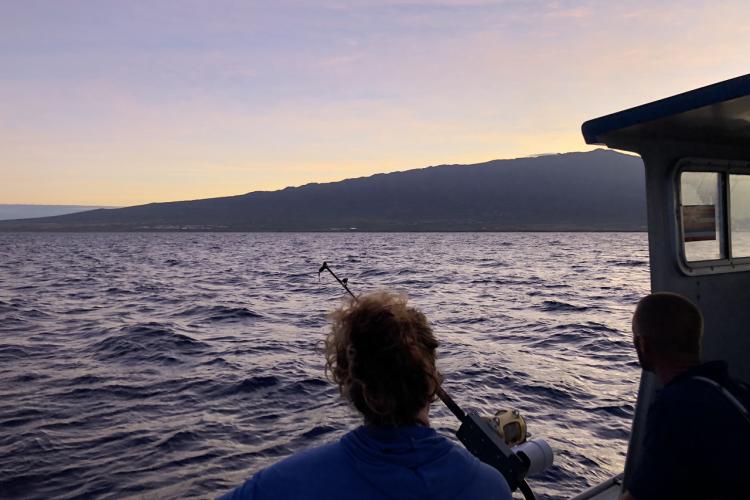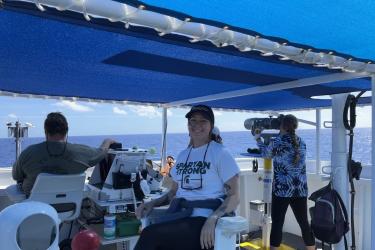As the light fades into darkness, the fishing vessel Sea Spirit chugs out of Honokohau Harbor and heads offshore of Kona, Hawai‘i. Fisherman Rick Reger is at the helm—by his side is Dr. Melanie Hutchinson, a shark biologist from the Pacific Islands Fisheries Science Center in Honolulu. Representing a unique collaborative effort between fishermen and scientists, Rick and Melanie are collecting information on pelagic shark species off the west coast of the Big Island to inform shark bycatch reduction strategies. I am lucky enough to "tag" along for the night to document their project.
Their mission on this night is to go ika shibi fishing, a night-time technique for catching tuna, and to tag any sharks that they may encounter as bycatch. “Some of the pelagics that these guys interact with do some really interesting things around the Big Island of Hawai‘i,” says Melanie, “so we are using a combination of electronic tags and ID tags to look at their interaction rates with the fishery.” They are also trying to understand the environmental variables that can predict presence and absence, when they show up and why, and what they are doing here. Their effort is part of Melanie’s larger study of pelagic shark ecology, habitat use, residence times, and biologically significant areas in this region.
In addition to tagging sharks, Melanie and her team are hosting a shark-tagging workshop in Kona. The workshop is teaching local fishers like Rick about the project and how they can get involved.

Bycatch in commercial fisheries is harming pelagic shark populations worldwide. As a result, fishery managers have implemented regulations to reduce interaction rates and increase post-release survival of sharks. In recent years, oceanic whitetip and silky sharks have shown significant declines in relative abundance. “[Fishermen] catch oceanic whitetips around here,” Melanie explains back onboard the Sea Spirit, “They were recently listed as threatened under the U.S. Endangered Species Act, so we are trying to get as much information about what they are doing around here as possible.” Fisheries managers have called for shark tagging studies to gain a better understanding of their basic ecology and stock structure in an effort to rebuild sharks stocks. Melanie’s project aims to answer this call for information and depends largely on her collaborative efforts and local knowledge of fishermen.


As we head back to the harbor after a long night of fishing, I overhear Melanie and Rick bouncing ideas off each other on fishing spots and shark tagging techniques. While our trip was “unsuccessful” because we didn’t tag any sharks, the simple act of being out on the water as a team, fishermen and scientists alike, was a huge success in my eyes. That is why biologists like Melanie are so unique: they are willing to dig into the bait and stay up all night to get the job done, and the fishermen are impressed. “Melanie’s participation with us, being in the trenches so to speak, coming out with us,” says Rick, “makes me and a lot of the other guys feel like we’re in this together.” And they are in this together—the results of this project will benefit the fishing community as well as the scientific community. This valuable data can identify hot spots for sensitive species and help managers develop bycatch mitigation strategies.
“One of the things I am most happy about with this project is the education that Melanie is offering,” Rick says, “it has definitely changed my perspective over 20 years of fishing... and has made me want to be more of a steward of the environment.”
Through continuous shark-tagging efforts and annual workshops, Melanie and her team have made a lasting impression on the fishing community in Kona.
Meet the Blogger

Ali Bayless is a Cetacean Biologist and Outreach Coordinator at the Pacific Islands Fisheries Science Center. Her research has been focused on cetacean-fishery interactions in Hawaii. She earned a B.S. in Ecology, Behavior and Evolution at the University of California, San Diego and an M.S. in Marine Biology at the University of Hawai‘i at Mānoa. She loves to spend her free time in the ocean, surfing, sailing and diving.

